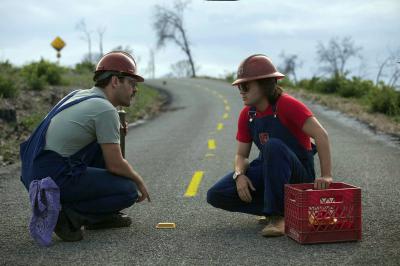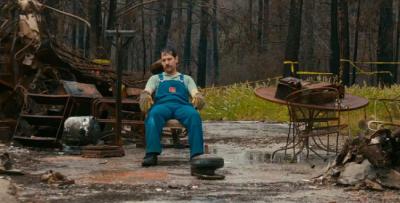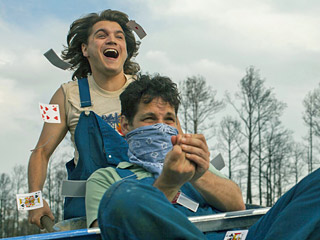By: debbie lynn elias
Loosely based on the Icelandic film Either Way, by Hafsteinn Gunnar Sigurosson, writer/director David Gordon Green puts his own patented spin on the story with PRINCE AVALANCHE. Starring Paul Rudd and Emile Hirsch, Green employs the idea of “anti-casting”, with his two actors being “two people who have no business being in a movie together”, going for the philosophical jugular with fresh, easy performances and refreshing storytelling that strip emotions and life to their barest, clearing the way for an offbeat and methodically entertaining movie-going experience.

Set against the burned out desolation of Bastrop, Texas in 1988 after a devastating fire (the actual fire was in 2011 and the worst in Texas history), Alvin and Lance are part of the State’s road crews tasked with replacing bot dots, road markers and repainting miles and miles of yellow dividing lines on rural roadways. Alvin and Lance are each as flawed as the charred remains of the region, yet garner a sympathy as we watch them day in, day out. Spending their days either in reflective, contemplative silence or sniping at each other like an old married couple, or better still, a 21st Century Oscar Madison and Felix Unger, the two are nothing, if not embraceable.
The Unger-esque Alvin has a hoity air about him, celebrating his self-perceived, high-minded intellect and skill set. Lance, on the other hand, who is Alvin’s girlfriend’s slacker younger brother who has one goal in life – get laid; anytime, anywhere and by anyone. He lives for weekends off when he goes back to civilization in search of female companionship. Meanwhile Alvin, prefers the solitude of the blackened once lush forest, intent to survive off the land with his superlative outdoor skills. As the weeks go by and we watch the paint dry, Alvin and Lance grow closer, gaining a better understanding of not only each other, but more importantly themselves.

I appreciate Paul Rudd stepping out of his usual comedic comfort zone with his performance of Alvin, reminding us of his dramatic acting chops, but, at first blush, watching PRINCE AVALANCHE and Rudd’s tacitness is like watching paint dry. However, in this slow (and I do mean slow) and tedious fashion, one begins to see the story and the character take shape, drawing you into the man, making you question what makes him tick. But while “silence” is an important part of Alvin’s character, and the film as a whole, there is just too much silence in many of Rudd’s scenes.
As Lance, Emile Hirsch has a few funny moments and also steps out of his comfort zone playing the seemingly not-so-bright/dull-pencil youngster, a performance which is more than interesting considering what we’re used to seeing from Hirsch. With Rudd’s Alvin an interesting dichotomy of calculated OCDC methodology, bordering on an almost autistic obsessiveness and forced calm, it becomes fascinating to watch Alvin get under Alvin’s youthful energetic skin.

Written and directed by David Gordon Green, one has to ask first ask, “Why?” Why something as tedious and “boring” as painting lines on desolate roads as a starting point for his version of this story? “I think one of the reason that particular profession appeals to be me is because it does give that meditative element. It’s one of those jobs that people don’t think about. You drive down the road everyday and you don’t think about somebody out there, putting those lines out there. I think it’s an under appreciated art form. There’s guys that can sell paintings and splatter paint on a canvas for millions of dollars and then there’s guys that will spent their whole life going down the highway and never even put a signature on a stripe.” Green does make the most of this meditative aspect with extended scenes of silence, allowing Alvin, Lance and the audience to embrace the sounds of the rebirth of nature. In many ways, by just watching and listening, PRINCE AVALANCHE becomes a lulling cathartic.
Using Either Way as a “blueprint” for PRINCE AVALANCHE, Green “just spent a day dictating that movie into a screenplay and then spent another couple days flipping it around and expanding certain things and emotionally investing myself in some of these characters with some dialogue. . .This one was pretty straightforward and I really jumped on the experience of streamlining the production process. I had the idea of remaking it in February and in July we were sound mixing the final product. Those are very quick, unusually quick, turnarounds for a movie.”

Employing a blend of scripted dialogue and improv, Rudd (whom Hirsch describes as a “master improvisor”) and Hirsch vacillate between the formats. According to Green, “There would be a long ass scene where Emile’s given a six-page monologue and that’s pretty much verbatim what was in the script. Then there’s other times where they’d let it loose.” A very sweet happy accident involves “[a] woman that Paul encounters going through the ashes of her home – all of that is improvised. That wasn’t in the script. That’s just a woman, that was her real story and we met her and incorporated her into the script. It was one of the those rare film opportunities where you can work both ways.”
Working well for the film is the physical comedy employed by Rudd and Hirsch, and never moreso than in a wrench-wielding chase across rocks, rills, mud and small ravines. Setting the film in the burned out Texas woods also provides ample opportunity to make use of the “emptiness” and “sadness” of the world around the boys, delivering a visual message of which Alvin and Lance are oblivious to – look around; these people, this land, has been burned to the ground and these people have nothing – making the problems of Alvin and Lance seem so insignificant. But, while each character is an interesting character study, at the end of the day, I still felt unfulfilled by the story as a whole.
A minimalist approach visually and with dialogue, and with everything being more or less an observational dual character study, David Wingo’s score, although engaging, needs to be a bit “beefier”.
Standout with PRINCE AVALANCHE is Tim Orr’s cinematography. With a visual tone that is wonderful to watch unfold through lighting and lensing, Orr creates a magical experience. Celebrating and embracing Mother Nature at her most bare, the imagery bodes a purity and freshness. As Green describes it, “We were there playing games with Mother Nature. She would throw us a curve ball and rain on us and we’d say, ‘Screw you. We’re gonna film in the rain.’ And [we] really turned that into a beautiful pantomime scene of Paul in this burnt out house. We really tried to incorporate that and embrace that. We didn’t have a lighting package so we would shoot into the sun. Typically if you’re in a movie and the sun’s in that direction [indicating], we’re gonna film you and you’re talking to me, then you’d like me. You’d turn around and we’d put silk up and we’d put some lights on me so I matched you. But in this movie, we’d shoot you in the morning and we’d shoot me in the evening so the good light was there behind you and then the good light was there behind me. We really strategized and used the tools of sunlight and the rain and the elements of nature and embrace them. Sometimes we would just shoot two profiles in close-up rather than traditional counter-shots.” This timing is also embraced in the editing and story construct, particularly with the appearance of a bright shining sun when Lance and Alvin each break through their personal emotional doldrums, creating a beautiful emotional metaphor.

Similarly, the use of the color yellow along with the primary colors of blue overalls and just bits of bright red, set a primary basic uncomplicated tone with yellow screaming “Caution” throughout the film. The use of red, extremely judicious in its use, is the most telling as it really does signify “stop” and “look” at the what’s happening – the old woman, the truck driver and his moonshine, the red warning lights on the road posts, etc.
Particularly effective is Orr’s lensing as it captures random elements of budding green, creeks, grass, life re-emerging. “You’ve got to love the caterpillars and turtles and elements as nature is starting to come back into its own. It was amazing to be there with a camera for the rebirth.” Just like Lance and Alvin are undergoing their own rebirth.
Written and Directed by David Gordon Green adapted from the story and screenplay Either Way by Hafsteinn Gunnar Sigurosson
Cast: Paul Rudd, Emile Hirsch












